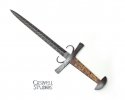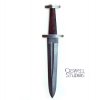I have a nice chunk of wrought iron that I found at an old mine/railroad/barge canal/etc. From everything I can determine it is wrought iron. The way it was pitted, the way it broke when I cut a chunk down and the striations in the material when I sanded and etched a piece of it. My question is, I want to use some for a guard and pommel on a dagger I am making. Is there anything I need to keep in mind when working with it? Finish, handling, etching, etc? Thank you! DonO
-
The BladeForums.com 2024 Traditional Knife is available! Price is $250 ea (shipped within CONUS).
Order here: https://www.bladeforums.com/help/2024-traditional/
You are using an out of date browser. It may not display this or other websites correctly.
You should upgrade or use an alternative browser.
You should upgrade or use an alternative browser.
working w/wrought iron
- Thread starter PaMtnBkr
- Start date
jdm61
itinerant metal pounder
- Joined
- Aug 12, 2005
- Messages
- 47,357
The more you forge it, the less of that desirable striated look you will get as you break down those occlusions. As for too much heat, it supposedly will crumble, but unlike say O1, I have been told that you can mash it back together to some degree.
- Joined
- Mar 12, 2006
- Messages
- 2,264
Stacy E. Apelt - Bladesmith
ilmarinen - MODERATOR
Moderator
Knifemaker / Craftsman / Service Provider
- Joined
- Aug 20, 2004
- Messages
- 38,246
For knife hardware uses, it is simplest to shape it with saws, files, and grinders. Once at the final shape, sand to 400 grit. Etch in FC to bring out the "character'.
jdm61
itinerant metal pounder
- Joined
- Aug 12, 2005
- Messages
- 47,357
I have done a few knives with wrought guards and buttcaps and people really like the way that stuff turns out. Once I get it finished and etched in FeCl, I hit is with a little bit of Brownell's Super Blue cold blue paste to darken it a bit and then rinse of the paste "card" it lightly with some OOOO steel wool. I do the same "double finish" with FeCl and Super Blue on 1018 and it gives me kind of a French gray look.
- Joined
- Nov 27, 2002
- Messages
- 2,087
A wrought iron cap, forged down from a 1/2" thk wagon rim, shaped to match stag,
etched, and hand buffed...

etched, and hand buffed...

- Joined
- Jul 27, 2003
- Messages
- 5,685
- Joined
- Jan 2, 2014
- Messages
- 297
lovely stuff with potential for lots of character!
if you have a forge (preferably charcoal^__^), a traditional japanese way to bring out the tekkotsu "iron ribs", simulating a very old surface, is to run the forge hot and keep the piece at a high orange-yellow heat with lots of oxygen, pulling it out every few seconds to wire brush and quickly put back in...as each area scales away at different rates due to carbon and slag content, the inner structure comes into strong relief...when finished brush to keep clean as it cools to black and then use as is or add a rust patinated or heat blued final surface...

if you have a forge (preferably charcoal^__^), a traditional japanese way to bring out the tekkotsu "iron ribs", simulating a very old surface, is to run the forge hot and keep the piece at a high orange-yellow heat with lots of oxygen, pulling it out every few seconds to wire brush and quickly put back in...as each area scales away at different rates due to carbon and slag content, the inner structure comes into strong relief...when finished brush to keep clean as it cools to black and then use as is or add a rust patinated or heat blued final surface...

- Joined
- Nov 20, 2008
- Messages
- 10,188
keep in mind it rusts if you look at it wrong. For that reason, I don't use it anymore.
- Joined
- Jul 27, 2003
- Messages
- 5,685
keep in mind it rusts if you look at it wrong. For that reason, I don't use it anymore.
I built my first take-down knife in the summer of '99 with a wrought guard and butt cap. It travels with me just about everywhere and I've never done anything out of the ordinary to protect it.
it lays on the bench in the work shop.
I carry it to knife shows and hammer-ins for show-and-tell.
Looks like the day I made it without one spec of rust.
And that's a fact.
- Joined
- Nov 20, 2008
- Messages
- 10,188
I built my first take-down knife in the summer of '99 with a wrought guard and butt cap. It travels with me just about everywhere and I've never done anything out of the ordinary to protect it.
it lays on the bench in the work shop.
I carry it to knife shows and hammer-ins for show-and-tell.
Looks like the day I made it without one spec of rust.
And that's a fact.
And I've seen it rust from rain, even after drying. I've seen it rust from getting blood on it, even after being cleaned. That's a fact too. It doesn't apply if the knife is kept indoors, but elements such as humidity, mud, blood, snow or rain can and does cause wrought to rust, sometimes almost overnight.
Last edited:
- Joined
- Oct 19, 2011
- Messages
- 5,039
Many, many wrought iron railings, gates, and other fabrications have lasted decades in the states and centuries overseas without rusting to dust. The low carbon/high slag or glass content makes the old wrought iron pretty weather proof. Some of the more recently made WI or mild steel sold as "wrought iron" will rust.
- Joined
- Aug 2, 2010
- Messages
- 1,611
I LOVE wrought iron! :thumbup: Don't be afraid to etch it deep if you want to achieve a "gnarly" look. I was messing around a while back and left this small san mai (wrought iron/L6/wrought iron) kiridashi in ferric chloride overnight.. ok I kinda forgot about it, but it was a "happy little accident" as Bob Ross would say!  But I really liked the way it turned out. I just went over it with a wire wheel afterwards, which got it nice and shiny. And yes, if/when you do decide to forge it, as was said above, forge it at pretty much welding temps, and don't hit it too hard or try to forge it in a hurry or it might start comming apart on ya.
But I really liked the way it turned out. I just went over it with a wire wheel afterwards, which got it nice and shiny. And yes, if/when you do decide to forge it, as was said above, forge it at pretty much welding temps, and don't hit it too hard or try to forge it in a hurry or it might start comming apart on ya.


~Paul
My YT Channel Lsubslimed


~Paul
My YT Channel Lsubslimed
Last edited:
- Joined
- Nov 20, 2008
- Messages
- 10,188
Many, many wrought iron railings, gates, and other fabrications have lasted decades in the states and centuries overseas without rusting to dust. The low carbon/high slag or glass content makes the old wrought iron pretty weather proof. Some of the more recently made WI or mild steel sold as "wrought iron" will rust.
More than likely because it's painted. I got some wrought five or six years ago when an old silo was being torn down, it was supposedly 100 years old. They stuff I got was deeply rusted, I had to take an angle grinder to it to find the steel. And, this was 100 year old wrought.
- Joined
- Jul 27, 2003
- Messages
- 5,685
The stuff I got was deeply rusted, I had to take an angle grinder to it to find the steel. And, this was 100 year old wrought.
Something different about your experience with wrought and mine.
I've been using it extensively for over a decade. The stuff I have was made in 1903 - I have about a 1/2 ton. It spent its entire life on a river through all seasons of exposure.
I can literally rub the surface rust off with my thumb and find shiny iron below. The rust has no depth whatsoever.
I'm an avid deer hunter and have been for 45 years. I hunt, I fish I camp and do everything with a knife with wrought hardware.
Any time there's even a slightest bit or dot of rust, it cleans off easily with some 0000 and a drop of oil.
The reason it was used in many cases in certain types of structures was because of its ability to RESIST rust.
There were many grades of wrought.
And when it comes to gates and railings and that sort of thing, most are simply mild steel and called "wrought" because of their design - not the material.








